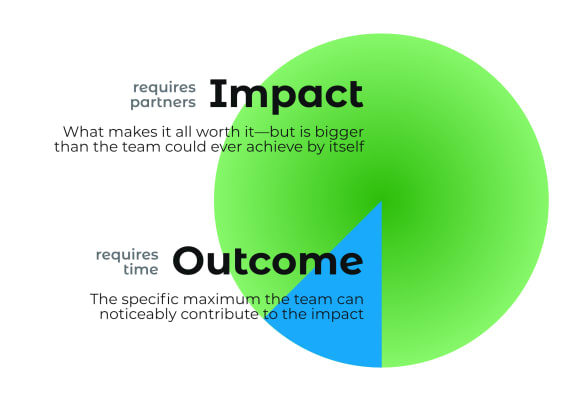Impact vs. Outcome
Aug 30, 2021 · 3min read
This is a subchapter of the article IOOI: Put Purpose to Work
Sometimes, knowing what’s Impact and what’s Outcome is a bit tricky. Here’s why it’s valuable to separate them, and a practical guide to distinguish the two.
Chapters
The Value of Differentiating ¶
Why should we make the difference, anyway?
For me, the main reason is to know where one’s accountability ends. If your company aims at increasing customer satisfaction by 20%—how many percentage points is your team responsible to contribute? IOOI will help knowing the overall ambition and one’s part in all of it before you start. It’ll also lead to the question: Who else is contributing to the same ambition?
The Difference Between Impact and Outcome ¶
Let’s use regnosis and start the process in a hypothetical, ideal future. A future that’s substantially more worth living for your team.
Since the ideal future usually is a magnitude better than what came before, many partners must have helped to create a profound impact for it to unfold. Your team can’t have shaped this ideal future entirely by itself. We’ll call this part Impact.
While your team needs help from partners to make the ideal future come to life, these partners need your team to help them, too. We’ll call your team’s contribution Outcome. Together, your and your partners’ Outcomes add up to the Impact.

So, the big difference is whether you can only influence or entirely control something. Note: The word “partners” suggests that you have no control over them. Otherwise, we could consider them as part of your team.
Example: SpaceX ¶
Impact: Elon Musk wants humankind to colonize Mars (which is impossible for him to achieve on his own). There are partners who are interested in the same thing.
Outome: Musk’s contribution so far will be affordable transportation to and from Mars. It’s insufficient to make the colonization happen by itself—but without it, colonization won’t occur either.
(Output: To achieve affordable transportation, Musk founds SpaceX and produces rockets that are reusable and hence massively bring down cost of transport. Input: Lots of money, expertise, innovation, etc.)
Considerations ¶
When filling out the IOOI Canvas, try to start at the top with Impact. Imagine a moment in the future when the desired Impact has already happened. Note down your first idea on how to describe that future.
Is it something in face of which your team simply has been insignificant no matter what? Then you went too far beyond the realm of what your team can influence. Break it down until you get in your team’s sphere of influence.
Once you found an Impact that can be influenced by your team, ask yourself (again looking back from the hypothetical, ideal future): Is it something that your team has been perfectly capable of achieving by itself? Is it something for which you can be accountable and can take credit? If yes, then you found a candidate for Outcome.
Of course, if the Impact eludes you and nobody else can answer your questions, pause for a moment. Is it possible that there’s no real purpose for the team the way it’s set up right now? Then it might be time to think about repurposing the team…
Chapters

Michael Schmidle
Founder of PrioMind. Start-up consultant, hobby music producer and blogger. Opinionated about strategy, leadership, and media. In love with Mexico. This blog reflects my personal views.